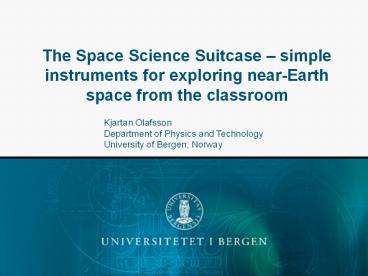The Space Science Suitcase - PowerPoint PPT Presentation
Title:
The Space Science Suitcase
Description:
A tri-axial magnetometer for monitoring ionospheric currents. ... controlling the camera and the magnetometer, and collecting the pictures and ... – PowerPoint PPT presentation
Number of Views:95
Avg rating:3.0/5.0
Title: The Space Science Suitcase
1
The Space Science Suitcase simple instruments
for exploring near-Earth space from the classroom
Kjartan Olafsson Department of Physics and
Technology University of Bergen, Norway
2
Why assembling an instrument package for use in
schools?
- Traditionally, experimental experience in upper
secondary school is mainly restricted to simple
laboratory exercises under controlled conditions,
frequently with a known correct answer. - Observations of uncontrollable natural phenomena
are traditionally left to academic scientists and
researchers, but in The knowledge promotion,
the latest reform in the 10-year compulsory
school and in upper secondary education, a
considerable emphasis is put on the student as a
scientist.
3
From the science curriculum for first year in
Secondary Education Act The aims for the
education are that the pupil shall be able to
- describe how the northern lights arise, and how
Norway has been and is an important country for
research in this field - explain the importance of the ozone layer with
respect to solar irradiation of the earth - explain what the greenhouse effect is and
elaborate on and analyse how human activities are
altering the energy balance of the atmosphere - elaborate on some possible consequences of the
increased greenhouse effect, including in Arctic
areas, and the measures that are being initiated
internationally to reduce the increase in the
greenhouse effect - carry out experiments with radioactivity,
half-life and background radiation and explain
these phenomena - describe characteristics of different types of
ionising radiation and explain how these are used
for technical and medical applications - explain how electromagnetic radiation from space
may be interpreted and provide information about
space
4
The contents of the suitcase Robust and user
friendly commercially available instruments
- A simple solar telescope (Sunspotter) for white
light for observing sunspots, and a narrow-filter
telescope for the H-a line (656.3 nm) for
observing solar prominences etc. - A tri-axial magnetometer for monitoring
ionospheric currents. - A simple hand held fixed slit spectroscope and a
hand held spectroscope with ajustable slit (max
resolution 2 nm). - A Geiger counter for monitoring background
radiation/cosmic radiation. - A commercial SLR digital camera (Canon EOS 400D)
with a fisheye lens for photographing the aurora. - A GPS for monitoring fluctuations in the inferred
coordinates at a fixed position. - A laptop for controlling the camera and the
magnetometer, and collecting the pictures and
measurements from the instruments. - Eventually, other instruments for atmospheric
monitoring.
5
(No Transcript)
6
What do we want to attain?
- Bring excitement about space phenomena to the
classroom. - Promote scientific literacy.
- Recruit more students to university studies in
the physical sciences in general and space
physics in particular.
7
In use

